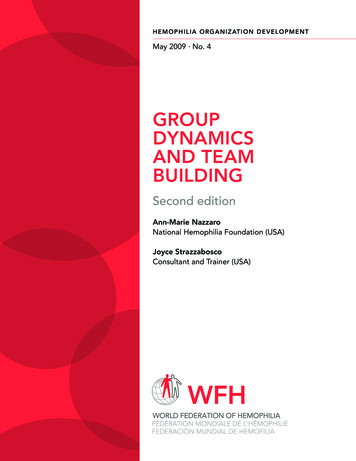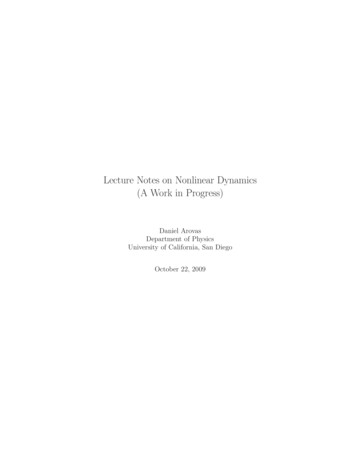
Transcription
DYNAMICS ANDSKILLS OF GROUPCOUNSELINGLAWRENCE SHULMANUniversity at Buffalo (SUNY)Australia Brazil Japan Korea Mexico Singapore Spain United Kingdom United States01956 00 FM pi-xxxix.indd i1/27/10 4:19:18 PM
Dynamics and Skills of Group CounselingLawrence ShulmanAcquisitions Editor: Seth DobrinAssistant Editor: Nicolas AlbertEditorial Assistant: Rachel McDonaldTechnology Project Editor: Dennis FitzgeraldSenior Marketing Manager: Trent Whatcott 2011 Brooks/Cole, Cengage LearningALL RIGHTS RESERVED. No part of this work covered by the copyrightherein may be reproduced, transmitted, stored, or used in any form or byany means graphic, electronic, or mechanical, including but not limited tophotocopying, recording, scanning, digitizing, taping, Web distribution,information networks, or information storage and retrieval systems, exceptas permitted under Section 107 or 108 of the 1976 United States CopyrightAct, without the prior written permission of the publisher.Marketing Assistant: Darlene MacananMarketing Communications Manager:Tami StrangContent Project Manager: Rita JaramilloCreative Director: Rob HugelArt Director: Caryl GorskaPrint Buyer: Paula VangRights Acquisitions Account Manager, Text:Roberta BroyerRights Acquisitions Account Manager, Image:Leitha Ethridge-SimsProduction Service: MPS Limited,A Macmillan CompanyText Designer: Diane BeasleyCopy Editor: Laura LarsonCover Designer: Diane BeasleyCompositor: MPS Limited,A Macmillan CompanyFor product information and technology assistance, contact us atCengage Learning Customer & Sales Support, 1-800-354-9706.For permission to use material from this text or product,submit all requests online at www.cengage.com/permissions.Further permissions questions can be e-mailed topermissionrequest@cengage.com.Library of Congress Control Number: 2009940482Student Edition:ISBN-13: 978-0-495-50195-4ISBN-10: 0-495-50195-6Brooks/Cole20 Davis DriveBelmont, CA 94002-3098USACengage Learning is a leading provider of customized learning solutions withoffice locations around the globe, including Singapore, the United Kingdom,Australia, Mexico, Brazil, and Japan. Locate your local office atwww.cengage.com/global.Cengage Learning products are represented in Canada byNelson Education, Ltd.To learn more about Brooks/Cole, visit www.cengage.com/brookscole.Purchase any of our products at your local college store or at our preferredonline store www.CengageBrain.com.Printed in the United States of America1 2 3 4 5 6 7 13 12 11 10 0901956 00 FM pi-xxxix.indd ii1/27/10 4:19:18 PM
For my sons David and Stuart, sources ofgreat pride and joy.01956 00 FM pi-xxxix.indd iii1/27/10 4:19:19 PM
01956 00 FM pi-xxxix.indd iv1/27/10 4:19:19 PM
Brief ContentsPA R T IThe Core Dynamics and Skills of Group Counseling 112345678910111213Underlying Assumptions About People, Groups, and Group Counseling 5Mutual Aid Processes in the Group 22Group Formation 39The Beginning Phase with Groups 60The Middle Phase of Group Counseling 99The Middle Phase Skills 110Working with the Individual in the Group 160Working with the Group as the “Second Client” 192Endings and Transitions with Groups 233Open-Ended, Single-Session, Activity, and Online Groups 256The Impact of Diversity on Group Practice 282Models of Group Counseling 336The Impact of Values, Ethics, and Legislation 370PA R T I IThe Variant Elements in Group Practice 389141516171819Group Counseling in Substance Abuse Settings 391Group Counseling in the Schools 443Group Counseling in Marital and Family Settings 484Group Counseling in Community Mental Health Settings 516Group Counseling in Job and Career Settings 542Group Counseling in Medical and Rehabilitation Settings 573Appendix AAppendix BAppendix CAppendix DResearch Methodology and Selected Findings 599Resilience Theory and Research 607Association for Specialists in Group Work (ASGW) Best Practice Guidelines 612Links to Associations, Practice Guidelines, and Codes of Ethics 618Glossary 619References 629Name Index 637Subject Index 641v01956 00 FM pi-xxxix.indd v1/27/10 4:19:19 PM
01956 00 FM pi-xxxix.indd vi1/27/10 4:19:19 PM
ContentsPreface xxiiiIntroduction: What Is This Book About? xxviiCore or Constant Elements in Group Counseling xxviiiThe Phases of Work xxviiiThe Preliminary or Preparatory Phase xxviiiThe Beginning or Contracting Phase xxixThe Middle or Work Phase xxxThe Ending and Transition Phas xxxiMutual Aid in Group Practice xxxiiiCase Examples Used in This Book xxxivThe “Fear-of-Groups Syndrome” xxxviConclusion xxxviiiPART IThe Core Dynamics and Skills of GroupCounseling 1CHAPTER 1Underlying Assumptions About People, Groups, andGroup Counseling 5What Is a Group Counseling Practice Theory? 6Practice Theory 6Models and Skills 7Empirical Testing 7Underlying Assumptions About Individual Psychology andSocial Interaction 8An Interactional Perspective 8A Counseling Group for Students Suspended from School for Violence 8An Oppression Psychology Perspective 10vii01956 00 FM pi-xxxix.indd vii1/27/10 4:19:19 PM
A Resilience Model and the Strengths Perspective 11Resilience Theory and Research 11Implications for Group Counseling 13Assumption of Strength for Change 13Group Leader Skill and the Working Relationship 15The Integration of Personal and Professional Selves 18Chapter Summary 20CHAPTER 2Mutual Aid Processes in the Group 22What Is Mutual Aid? 23The Dynamics of Mutual Aid 24Sharing Data 24The Dialectical Process 25Discussing a Taboo Area 26The All-in-the-Same-Boat Phenomenon 27Developing a Universal Perspective 27Mutual Support 28Mutual Demand 29Individual Problem Solving 30Rehearsal 31The Strength-in-Numbers Phenomenon 34Summary of the Dynamics of Mutual Aid 34Obstacles to Mutual Aid 34Identifying the Common Ground 35The Complexity of the Group-as-a-Whole 35Difficulty of Open Communications in Taboo Areas 35The Role of the Group Leader 36Chapter Summary 37CHAPTER 3Group Formation 39Preparing for Group Practice 40Engaging Other Professionals in Developing the Group 40Achieving Consensus on the Service 41Identifying Group Type and Structure 43Group Versus Individual Counseling 44Agency or Setting Support for Groups 45viiiContents01956 00 FM pi-xxxix.indd viii1/27/10 4:19:19 PM
Group Composition, Timing, and Structure 46Group Member Selection 48Group Composition and Age of the Members 48Race, Ethnicity, and Language 49Group Timing 51Form Follows Function in Group Formation 51Group Structure, Setting, and Rules 53Section Summary 54Interviewing Prospective Members 54Strategizing for Effective Referrals 55Recruiting Men Who Have Been Physically Abusive to Their Partners 56Counselor Skills in the Initial Interviews 57Recruiting a Member to a School-Based Parents’ Group 57Chapter Summary 59CHAPTER 4The Beginning Phase with Groups 60The Dynamics of First Group Sessions 61What Do We Know About First Group Sessions? 61What Would We Like to Achieve—Our Valued Outcomes? 63The Contracting Skills: Establishing a Structure for Work 64Illustration of a First Group Session: The Couples’ Group 66The Initial Stage of the First Session 66Clarifying Purpose and Role 67Reaching for Feedback on the Purpose: The Problem-Swapping Exercise 68Silence in the First Session 69A Member Begins: The Authority Theme Emerges 69Returning to the Authority Theme 74Integrating the Late Couple and Maintaining the Discussion 75The Middle Stage of the First Session 77Frank and Jane and Issues of a Blended Family 78Lou the Internal Leader: How Do We Handle Anger in Our Relationships? 79Rose Decides to Speak 82The Ending and Transition Stage of the First Session 83Wrap-up and Session Evaluation 84Reaching for the Negatives 85The Rules of the Group 85Reflections on the First Session 86Recontracting After a First Session 86Recontracting with Your Own Group 87An Open-Ended Group for Battered Women in a Shelter 87A Chance for a New Beginning and a Different First Session 90Contents01956 00 FM pi-xxxix.indd ixix1/27/10 4:19:19 PM
Co-leadership in Groups 91Reflective Practice in Group Co-leadership 92Positive Potential in Co-leadership 93Skill in Dealing with Co-leader Conflicts in the Group 94A Final Comment on Co-leadership 97Chapter Summary 98CHAPTER 5The Middle Phase of Group Counseling 99The Middle or Work Phase in Group Counseling 99The Role of the Group Leader 100Reaching for Individual Communication in the Group 101A Group for Grieving Children 102Grieving Adults: Loss of a Friend, Partner, or Relative to AIDS 103Reaching for the Group Response to the Individual 104A Psychiatric Day Patients’ Group 104Reaching for the Work When Obstacles Threaten 106Teenager in a Residential Center Raising a Difficult Subject 106Mothers of Children with Hyperactive Diagnosis 107Avoiding Individual Counseling in the Group 108Chapter Summary 109CHAPTER 6The Middle Phase Skills 110Skill Factors in the Middle Phase 111The Preliminary Stage 112Sessional Tuning-in Skills 112The Beginning Stage 112Sessional Contracting Skills 112A Preadoption Parenting Group 112The Middle Stage 113Flow of Affect Between the Group Members and the Leader(s) 114Elaborating Skills 114Containment 114Focused Listening 115Questioning 115xContents01956 00 FM pi-xxxix.indd x1/27/10 4:19:19 PM
Reaching Inside Silences 116Moving from the General to the Specific 119Empathic Skills 121Reaching for Feelings 123Displaying Understanding of the Member’s Feelings 123Putting the Member’s Feelings into Words 124Research on Empathy 125Sharing Leader’s Feelings 126Integrating the Personal and the Professional 126When the Group Leader Is Angry with the Member 127Expressing a Group Leader’s Investment in the Success of the Member 128Sharing Feelings Associated with Life Experiences 128Boundary Issues in Sharing the Group Leader’s Feelings 129Sexual Transference and Countertransference Feelings 130Making a Demand for Work 132Partializing Group Member Concerns 134Holding to Focus 136Checking for Underlying Ambivalence 137Challenging the Illusion of Work 138Supporting Group Members in Taboo Areas 139Identifying Taboo Subjects 140Changing the Culture of the Group 141Dealing with the Authority and Intimacy Themes 141Research on Dealing with Taboo Subjects 143Identifying Content and Process Connections 144Process and Content That Relates to the Authority Theme 144Sharing Data 146Providing Relevant Data 147A Group for Preadoptive Couples 147Providing Data in a Way That Is Open to Examination and Challenge 149Providing Data as a Personal View 150Ethical Dilemmas in Withholding Data 151Helping the Group Members See Life in New Ways 152Redefining the Behavior of the Significant Other 152The Ending and Transition Stage 153Summarizing 154Generalizing 154Identifying the Next Steps 154Rehearsing 155Identifying “Doorknob” Communications 155Couples Group and Sexual Issues 156Mothers with Children Diagnosed as Hyperactive 157Chapter Summary 159Contents01956 00 FM pi-xxxix.indd xixi1/27/10 4:19:19 PM
CHAPTER 7Working with the Individual in the Group 160The Concept of Role in a Dynamic System 161The Impact of Oppression on Social Role 161Formal and Informal Roles in the Group 162The Scapegoat 163African American and Hispanic Teenage Girls in a School 164Strategies for Addressing the Scapegoating Pattern 170The Deviant Member 171Extreme Versus Mild Deviance 171Parent Recruitment Group Example 171Reaching for the Underlying Message of Deviant Behavior 172A Group for Children Having Trouble in School 172Deviant Behavior as a Functional Role 173Counseling Group at a Mental Health Center: What’s the Purpose of This Group? 174Deepening Discussion in a Parenting Group 175The Internal Leader 176Dealing with Acting-Out Adolescents: A Community Center Group 176The Gatekeeper 180Teenage Survivors of Sexual Abuse 181The Defensive Member 181A Defensive Father in a Parents’ Group 182The Quiet Member 184Group Leader Strategies 185The Member Who Is Afraid to Speak 185The Member Who Feels Left Out 186Men’s Group: A Member Reaches Out to the Quiet Member 188The Monopolizer 188A Psychoeducational Parents’ Group for Children with Traumatic Brain Injury 189Chapter Summary 191CHAPTER 8Working with the Group as the “Second Client” 192The Group-as-a-Whole 193The Group as an Organism 193Developmental Tasks for the Group 195The Relationship to the Leader: The Authority Theme 196The Bennis and Shepard Model: The Issue of Authority 196Who Owns the Group? The Couples’ Group and the Authority Theme 197xiiContents01956 00 FM pi-xxxix.indd xii1/27/10 4:19:19 PM
The Group Leader as the Outsider 199Parents of Hyperactive Children: The Leader as the Outsider 199The Group Leader’s Demand for Work 200Posttraumatic Stress Disorder Vietnam Veterans’ Group 201The Group Leader’s Limitations 206Parents of Hyperactive Children: Can Someone Cheer Me Up? 206The Group Leader as a Caring and Giving Person 207The Couples’ Group and the “Crying Chair” 207Dealing with Group Member Relationships: The Intimacy Theme 208Cohesion and Therapeutic Alliance to the Group-as-a-Whole 208The Bennis and Shepard Model 210College Student Counseling Group and the Intimacy Theme 211The Stone Center: Intimacy and the Relational Model 213Paradox 214Connection 214Resonance 215A Support Group for Women with Cancer 215Anger in a Graduate Class on Practice: Impact of Trauma on the Practitioner 220Developing a Culture for Work 222Norms and Taboos 222Bion’s Emotionality Theory 223Parents of Hyperactive Children: Accepting Difficult Feelings 225Helping Members Develop a Structure for Work 227An Outpatient Group for Young Recovering Addicts 228Helping Group Members Negotiate the Environment 230Adolescents: Acting-Out Behavior in the Community Center 230The Homans Social Systems Model: Relating to the Environment 231Chapter Summary 232CHAPTER 9Endings and Transitions with Groups 233The Ending Phase of Group Practice 234Ethical Issues Related to Endings 235The Group Leader Takes a Leave of Absence: Transitioningto an Interim Leader 236Individualizing the Ending and Transition to MeetIndividual Needs 237The Dynamics and Skills of Endings 238Flow of Affect in the Ending Phase 238Timing and the Ending Phase 239Contents01956 00 FM pi-xxxix.indd xiiixiii1/27/10 4:19:19 PM
Stages of the Ending Process 240Denial 240Anger 241Mourning 241Trying It On for Size 242Farewell-Party Syndrome 242Group Leader Strategies with Regard to Ending 243Group Leader Strategies with Regard to Transition 243Additional Group Illustrations 244A Support Group for Patients with Multiple Sclerosis 244Adult Female Survivors of Childhood Sexual Abuse: Ending over Time 247Chapter Summary 255CHAPTER 10Open-Ended, Single-Session, Activity,and Online Groups 256The Open-Ended Group 257Bringing a New Member into a Group for Persons with AIDS 258The Single-Session Group 260Information Group: Foster Parent Recruitment 261Informal Event Group: Remembering the Holocaust 263Activity in Groups 264Functions of Activity in a Group 265Two Categories of Activity Groups 265Children Dealing with Their Parents’ Separation and Divorce 268Internet Online Groups 277Internet Chat Text Group Providing Follow-up Mental Health Care 278An Online Web-Based Video Support Group for Caretakers 279An Online Audio and Text Educational Group for Graduate Students 280Chapter Summary 281CHAPTER 11The Impact of Diversity on Group Practice 282Common Definitions 283Guidelines for Diversity Best Practices 284Discussing Taboo Subjects 286Race and Ethnicity 287Leading an Educational Group for Hong Kong Asian Counselors 288Hispanic Parents of Children with Cancer 290xivContents01956 00 FM pi-xxxix.indd xiv1/27/10 4:19:19 PM
Age and Stage of the Life Cycle: The Geriatric Population 292Some Differences in Working with OlderPeople in Groups 293Resilience and Life Span Theory 294Geriatric Reminiscence Group 294Physical Ability and Group Culture 301A Summer Camp Group for Physically Challenged Adults 301Ending with Hearing-Impaired Teenagers’ Group 302Sexual Orientation: Lesbians, Gays, Bisexuals,and Transgender Clients (LGBT) 305Definitions 305The Oppression Perspective 306The Strengths Perspective for GLBT Clients 307Strategies for GLBT Sensitive Practice:The School Counselor 308Homosexual Veterans with AIDS—Dealing with theEffects of Oppression 309Intercultural Issues: Group Leader–Member Differences 314A Male Counselor Co-leading a Group for WomenWho Have Been Abused 315White Female Counselors with African American Inner-CityHigh School Girls 316Intracultural Issues: When the Group Leader Is theSame as Group Members 326African American Clients: Dealing with Issues of Authority and Racism 326Inter- and Intracultural Issues Between Group Members 328Housing Complex Group for Elderly Persons 329Chapter Summary 335CHAPTER 12Models of Group Counseling 336Evidence-Based Practice (EBP) 337Motivational Interviewing (MI) 339Solution-Focused Practice (SFP) 342Major Assumptions on the Nature of the Helping Relationship 343Role of the Solution-Focused Group Leader 344Defining Techniques 344Cognitive-Behavioral Therapy (CBT) 346Cognitive-Behavioral and Supportive-Expressive Groups forWomen Diagnosed with Breast Cancer 346CBT Group for Chronic Mental Patients 347Contents01956 00 FM pi-xxxix.indd xvxv1/27/10 4:19:19 PM
Feminist Practice 348Feminist Practice Typology 348The New Psychology of Women 349Feminist Group Practice 351Battered Women’s Group 352Feminist Perspectives on Work with Other Populations 355Take Back the Night March 355Religion and Spirituality 356Definitions 356Group Interventions: The Spiritual/Religious Autobiography 358Practice in Response to Trauma and Extreme Events 359Crisis Theory and Crisis Intervention 360Crisis Intervention Stress Management 361Trauma Groups 362Groups for Children Dealing with the Trauma of 9/11 363Forgiveness Exercises 365Impact of Trauma on the Professional 366A Single-Session Vicarious Traumatization Model for Trauma Workers 367Impact of Traumatic Events on Practice 368Chapter Summary 368CHAPTER 13The Impact of Values, Ethics, and Legislation 370Values and Ethics in Group Counseling Practice 371Definitions of Values and Ethics 371Code of Ethics 372Ethical Dilemmas and Ethical Decision Making 372Ethics Audit and Risk Management Strategy 374Guidelines for Practice in Group Work 374Survivors of Sexual Abuse Group and the Mandated Reporter 376Social Changes and Their Impact on Ethical Practice 378Managed Care 378End-of-Life Decisions 380The Impact of Legislation and the Courts 382Confidentiality and Privileged Communications 382Implications of the Federal Health Insurance Patient Protection Act (HIPPA) 384Confidentiality and Group Counseling: Unique Dilemmas 384Informed Consent 385The Duty to Warn 386Chapter Summary 388xviContents01956 00 FM pi-xxxix.indd xvi1/27/10 4:19:19 PM
PART IIThe Variant Elements in Group Practice 389CHAPTER 14Group Counseling in Substance Abuse Settings 391What Do Counselors Do in Substance Abuse Settings? 392Substance Abuse and Substance Abuse Treatment 392Self-Help Organizations 393Integrated Approach to Group Treatment 394Research on the Use of Group Methods 395Substance Abuse and Culture 396Group Counseling with Active Substance Abusers 397Group Counseling with Male Active Substance Abusers 397Court-Mandated Group for Male Drunk Drivers: The Precontemplation Stage 397Court-Mandated Group for Male Drunk Drivers: The Contemplation Stage 399Group Counseling with Female Active Substance Abusers 402Maintaining Sobriety for Women Trauma Survivors 403Support Groups for Protecting Recovery 409Women’s Recovery Group: Fending Off the Dealers 409Group Counseling with Clients with a Dual Diagnosis 410A Dual-Diagnosis Group for Women: Mental Illness, Substance Abuse,and the Double Stigma 411Group Work with Persons with AIDS Who Are in Early Substance Abuse Recovery 413Group Counseling with the Substance Abuser’s Significant Others 429Adult Daughters of Alcoholics: Lowering the Walls of Denial 430A Women’s Open-Ended Codependent Group: Dealing with Substance and Physical Abuse 437Chapter Summary 442CHAPTER 15Group Counseling in the Schools 443What Do Counselors Do in School Settings? 444Group Work in Schools 445Four General Types of Groups 446Race, Class, and the Emerging Adolescent 447Social Justice, the Advocacy Role, and Idiosyncratic Credits 448Group Work in the Elementary School 451Ten to Eleven-Year-Old Girls with an Acting-Out Group Member 451Inner-City Elementary School Children: The Impact of Violence in the Family 458A Group for Sixth-Grade Girls in Transition to Middle School 459Working with Mothers of Underachieving Sixth-Grade Boys 461Contents01956 00 FM pi-xxxix.indd xviixvii1/27/10 4:19:19 PM
Group Work in the Middle School 462Adolescent Boys’ Group Dealing with Disruptive Classroom Behavior 463Peacemaking Circle Group in the Classroom: From Acting Out to “Krumping” 465Informal Lunchtime Meetings with 9- to 12-Year-Old Girls 468Alternative Public Day School: Parents of Children with Emotional and BehavioralDifficulties 470Group Work in the High School 473The VISA Center: A 2-Week (10-Day) Intensive Intervention for Suspended Students 473Group Work and Substance Abuse Prevention 476Educational Substance Abuse Group: Is It a Class or a Group? 476High School Students in a Diversion Program 481Chapter Summary 482CHAPTER 16Group Counseling in Marital and Family Settings 484What Do Counselors Do in Marital and Family Settings? 485What Do We Know about Couples, Families,and Family Practice? 486What Is Unique About Working with Couples or Families? 487Selected Concepts from Family Therapy Theory 487Nathan Ackerman 488Murray Bowen 488David Freeman 489Carl Rogers (Person-Centered Approach) 489Working with Multiple Family Groups 490Multiple Family Group Therapy (MFGT) 490Psychoeducational Multifamily Groups (PMGs) 491Multifamily Group with Latino Immigrants Addressing9/11 Losses 492Evolving Group Structure and Style 492Cultural Competence 493Workers’ Process 494Married Couples’ Groups 494Dealing with the Sexual Taboo 494Sessional Contracting in the 19th Session 496Emergence of Anger at the Group Leaders and the Process/Content Integration 497Legitimizing the Expression of Anger 499Single-Parent Groups 500Life Cycle Developmental Issues 501A Single Parents’ Group: Short-Term Interventions 502Relationship to the Children 506xviiiContents01956 00 FM pi-xxxix.indd xviii1/27/10 4:19:19 PM
Preadoption Groups for Couples 512First Session of a Preadoption Group for Couples: Confidentialityand the Illusion of Work 512Preadoption Group: Dealing with Friends and Relatives 513Chapter Summary 514CHAPTER 17Group Counseling in Community MentalHealth Settings 516What Do Group Counselors Do in Community Mental Health Settings? 516Group Counseling with Troubled Teenagers 518Outpatient Teen Psychiatric Group 519Group Counseling with Adult Clients with Relationship Problems 524A Group for Depressed Men and Women with Relationship Problems 525Groups for Management of Chronic Pain and Posttraumatic Stress 529Veterans’ Outpatient Clinic 529Groups for Parents and Caretakers 534Fathers of Children Attending a Clinic for Behavior Problems 534Groups in an Elder Community Setting 537A Group for the Visually Impaired Elderly: The Death of a Member 538Chapter Summary 540CHAPTER 18Group Counseling in Job and Career Settings 542What Do Counselors Do in Job and Career Settings? 542Group Counseling for Adult Clients Seeking Work 544Engaging Group Members in First Sessions in the Face of Resistance 544A Job Counseling Group for Women on Public Assistance 544First Session for Ex-offenders Mandated to Attend a Job Training Group:The Meaning of Resistance 552The Emotional Impact of the Reality of the Job Market 556Dealing with Despair and Long-Term Unemployment 556The Impact of Group Member Differences in More Heterogeneous Groups 557Employment Groups Including Persons with Special Needs 558Taking Some Responsibility for Employment Problems 560Losing a Job: The Gatekeeper Role 560Getting Angry on the Job and Then Getting Fired: The Defensive Member 562Job-Related Group Counseling with Youth 563Older Teens in a Transition to Independence Group: The Scapegoat Phenomenon 564Worksite Training Program for Teenagers: Addressing Sexual Harassment 566Chapter Summary 572Contents01956 00 FM pi-xxxix.indd xixxix1/27/10 4:19:19 PM
CHAPTER 19Group Counseling in Medical and RehabilitationSettings 573What Do Counselors Do in Medical and Rehabilitation Settings? 573Stage of the Problem and Engagement with the Setting 574Group Counseling for Hospital and Rehabilitation Inpatients 574Group Counseling with Paraplegics in a Rehabilitation Center 574Caregiver Support Group in a Hospice Setting 576Group Counseling and the Impact of the Setting 582Patient Empowerment Through a Newspaper in a VA Hospital 583Group Counseling for Medical Outpatients and Their Families 590Denial, Gender, and Culture in a Living-with-Cancer Group 590Chapter Summary 598APPENDIX AResearch Methodology and Selected Findings 599Child Welfare Practice and Supervision Study 600Description of Study Participants 600Study Limitations 600Findings on Skills Related to Silences 601Child Welfare Practice and Supervision Study 2 601Category Observation System for Analyzing Counselor-Client Interaction inIndividual and Group Practice 601Related and Relevant Studies 603Supporting Clients in Taboo Areas 603The VISA Center for Students Suspended from School for Violence, SubstanceAbuse, or Possession of Weapons 603Profile of Suspended Students 604Impact on Survival Rate (Length of Time Between Resuspensions) 604Exit Interview Findings and Other Outcomes 605Summary 605APPENDIX BResilience Theory and Research 607Developmental Psychology Theory and Research 607Stressors, Risk, and Personal and Environmental Factors 608Parental Involvement 609xxContents01956 00 FM pi-xxxix.indd xx1/27/10 4:19:19 PM
Community Violence 609Poverty 610Cognitive Hardiness and Coping Style 610Summary 611APPENDIX CAssociation for Specialists in Group Work (ASGW)Best Practice Guidelines 612Preamble 612Section A: Best Practice in Planning 612A.1. Professional Context and Regulatory Requirements 612A.2. Scope of Practice and Conceptual Framework 613A.3. Assessment 613A.4. Program Development and Evaluation 613A.5. Resources 614A.6. Professional Disclosure Statement 614A.7. Group and Member Preparation 614A.8. Professional Development 614A.9. Trends and Technological Changes 615Section B: Best Practice in Performing 615B.1. Self Knowledge 615B.2. Group Competencies 615B.3. Group Plan Adaptation 615B.4. Therapeutic Conditions and Dynamics 616B.5. Meaning 616B.6. Collaboration 616B.7. Evaluation 616B.8. Diversity 616B.9. Ethical Surveillance 616Section C: Best Practice in Group Processing 616C.1. Processing Schedule 616C.2. Reflective Practice 617C.3. Evaluation and Follow-Up 617C.4. Consultation and Training with Other Organizations 617Contents01956 00 FM pi-xxxix.indd xxixxi1/27/10 4:19:19 PM
APPENDIX DLinks to Associations, Practice Guidelines,and Codes of Ethics 618GLOSSARY 619REFERENCES 629NAME INDEX 637SUBJECT INDEX 641xxiiContents01956 00 FM pi-xxxix.indd xxii1/27/10 4:19:19 PM
PrefaceOverviewMy purpose in writing this book is to present and illustrate an approach to groupcounseling that incorporates the powerful healing process of mutual aid in all typesof groups (e.g., psychotherapy, psychoeducational, counseling, activity focused)and in the full range of settings in which group counseling is practiced (e.g., substance abuse rehab centers, schools, mental health clinics). I also wish to describeand illustrate how the use of mutual aid can enhance existing group practice modelsincluding those defined as evidence based.The development of Dynamics and Skills of Group Counseling was guided by theory,empirical research, and the practice wisdom of colleagues, my own group practice,and my teaching efforts over the years with thousands of group leaders who werestudents in my classes or participants in training workshops. Above all, this book ispractical in nature. Detailed illustrations including dialogue from actual groups areused to connect theory to practice and to address the day-to-day realities of leadingcounseling groups. I wrote the book as if I were responding to the most common,natural questions and concerns of the reader, and in a conversational tone that Ihope the reader finds more engaging and lively than other textbooks.Writing a book that would be beneficial to both beginning and experienced counselorswho may one day apply their group counseling training into several different settings, Ihave divided the book into two major parts. Part 1 consists of 13 chapters in which the coregroup dynamics and leadership skills that make up what I call the “constant” elements ofgroup practice are presented and illustrated with detailed examples from different settings,group types, memberships, and group leadership styles. A central theme is that while setting, group purpose and structure, and population and group member issues may make upthe “variant” elements of group counseling, a common core exists to all group practice.Also included in Part 1 is a detailed discussion of the phases of work, a framework of timethat can help students both understand how groups work and develop a model for intervention. Part 2 of the book contains six chapters that focus on the implementation of thekey concepts presented in Part 1, organized according to counselor specialties, settings,populations, and problems. The central themes introduced in Part 1 are now adapted, eachin their own chapter, to working in the following settings and problem areas: Substance abuse Schools Marital and family Community mental health Job and career Medical and rehabilitationxxiii01956 00 FM pi-xxxix.indd xxiii1/27/10 4:19:19 PM
The six areas chosen for inclusion appear to be the ones most often involving grouppractice. Although the chapters focus on different forms of setting-specific groupcounseling, readers are e
v PART I The Core Dynamics and Skills of Group Counseling 1 1 Underlying Assumptions About People, Groups, and Group Counseling 5 2 Mutual Aid Processes in the Group 22 3 Group Formation 39 4 The Beginning Phase with Groups 60 5 The Middle Phase of Group Counseling 99 6 The Middle Phase Skills 110 7










